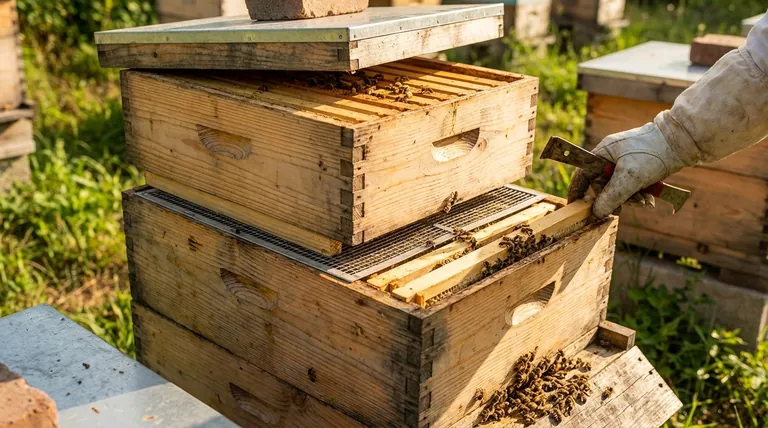At its core, the challenge of monitoring queen space in a Langstroth hive stems directly from its modular design. The system encourages beekeepers to artificially separate the queen's laying area (the brood nest) from the honey storage area, which is an unnatural arrangement for the colony and requires active, hands-on management to prevent problems.
The Langstroth hive’s greatest strength—its standardized, interchangeable boxes designed for efficient honey production—is also the source of this management challenge. It forces the beekeeper to constantly assess and manage an artificial boundary that the bees will naturally try to ignore.

The Principle of a Divided Colony
To understand the challenge, you must first understand the fundamental difference between a natural bee nest and one managed in a Langstroth hive.
A Natural Brood Nest
In nature, a colony creates a single, contiguous nest. The queen lays eggs in the center, and the bees store pollen and then honey in an arch-like pattern around and above this brood. The entire nest expands and contracts organically as one unit.
The Langstroth's Vertical Separation
The Langstroth system consists of vertically stacked, interchangeable boxes. Beekeepers use this design to create a division of labor within the hive that serves human goals.
The lower boxes are designated as the brood chamber, where the queen lays her eggs. The upper boxes, called honey supers, are intended purely for honey storage.
How This Separation is Enforced
To keep the system "clean" for honey harvesting, many beekeepers place a queen excluder between the brood chamber and the honey supers. This is a screen with gaps large enough for worker bees to pass through but too small for the larger queen.
This physically restricts the queen to the lower boxes, ensuring the honey supers contain only honey, not eggs or larvae.
The Management Challenge This Creates
This artificial restriction is the root of the monitoring problem. You cannot gauge the queen's available space by simply looking at the hive's total size.
The "Out of Sight" Problem
With the queen confined to the bottom boxes, you have no way of knowing her status without a full teardown of the hive. You must remove the honey supers to access and inspect the brood chamber frame by frame.
Assessing a "Bound" Queen
A queen can run out of laying space in two primary ways. The brood chamber can become brood-bound (full of eggs and larvae) or honey-bound (workers backfill empty cells with nectar and pollen). Both situations are invisible from the outside.
The High Stakes of Mismanagement
Failing to provide adequate laying space is one of the primary triggers for swarming. A queen who feels she has no room to lay will signal the colony to prepare to leave and find a new home, costing the beekeeper half their workforce and the old queen.
Understanding the Trade-offs
The Langstroth design's popularity is built on a specific set of advantages that come with clear disadvantages.
Pro: Unmatched Efficiency for Honey Production
The separation of brood and honey is incredibly efficient for harvesting. You can remove entire boxes of honey without worrying about disturbing the nest or getting brood in your extractor. The hive's standardized components, built around the principle of bee space, allow for easy scalability.
Con: More Labor-Intensive Management
This efficiency comes at the cost of working against the colony's natural instincts. It requires more frequent and invasive inspections to manage the artificial boundary, check for swarm preparations, and ensure the queen has sufficient room.
Making the Right Choice for Your Goal
Your management strategy should reflect your primary objective as a beekeeper.
- If your primary focus is maximizing honey production: You will likely use a queen excluder and must commit to regular, thorough inspections of the brood chamber every 7-10 days during the main season.
- If your primary focus is a more natural, low-intervention approach: Consider running your hive without a queen excluder, allowing the nest to expand upward naturally, but be prepared for a more complex honey harvest.
Ultimately, understanding this core design trade-off transforms a management challenge into a predictable and solvable task.
Summary Table:
| Challenge | Root Cause | Consequence |
|---|---|---|
| "Out of Sight" Queen | Vertical separation of brood and honey boxes | Requires full hive teardown for inspection |
| Invisible Space Issues | Queen confined to lower brood chamber | Risk of brood-bound or honey-bound conditions |
| High-Stakes Mismanagement | Artificial boundary goes against natural instincts | Primary trigger for swarming behavior |
Master Langstroth hive management with the right equipment.
Effective beekeeping requires reliable, high-quality supplies to conduct the frequent inspections necessary for managing queen space and preventing swarming. HONESTBEE supplies commercial apiaries and beekeeping equipment distributors with the durable, wholesale-focused beekeeping supplies and equipment needed for successful, large-scale operations.
Contact our experts today to discuss your wholesale needs and ensure your hives are productive and manageable.
Visual Guide

Related Products
- Langstroth Bee Hives Bee Keeping Box for Beginners Beekeeping
- HONESTBEE Professional Multi-Functional Hive Tool with Ergonomic Wood Handle
- Long Langstroth Style Horizontal Top Bar Hive for Wholesale
- HONESTBEE Advanced Ergonomic Stainless Steel Hive Tool for Beekeeping
- Ergonomic Two Person Foldable Hive Lifter
People Also Ask
- Why are Langstroth hives recommended for beginners? Unmatched Support & Standardization
- What basic equipment is needed to start beekeeping? Your Essential Guide to a Confident Start
- What is the best type of bee hive for beginners? Start with the Proven Langstroth Standard
- How does the orientation of the hive sides benefit comb construction? Ensure Straight, Movable Combs for Easier Hive Management
- Why were wooden hives traditionally preferred? For Natural Beekeeping Aligned with Bee Biology



















